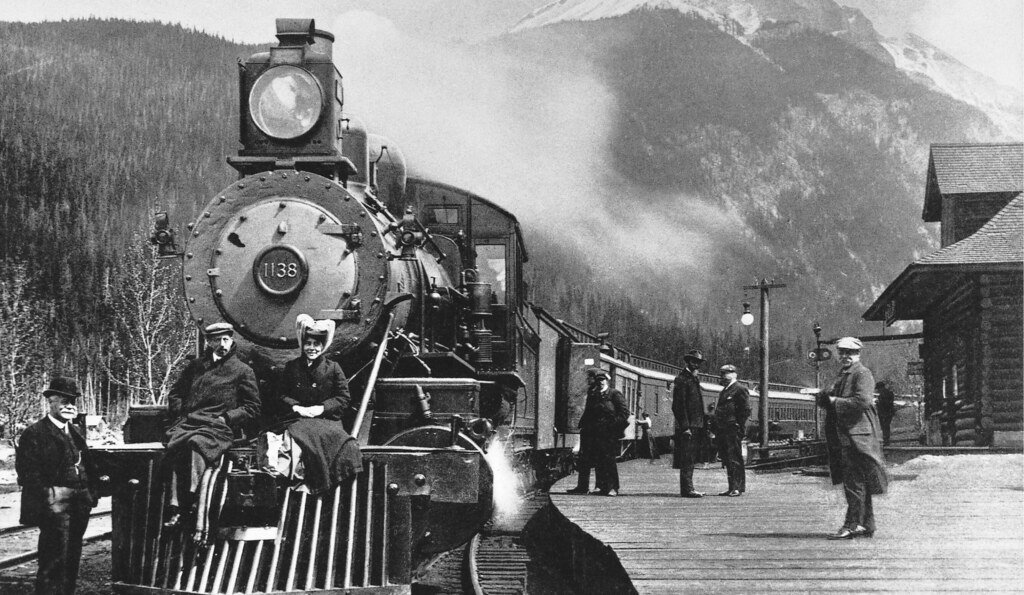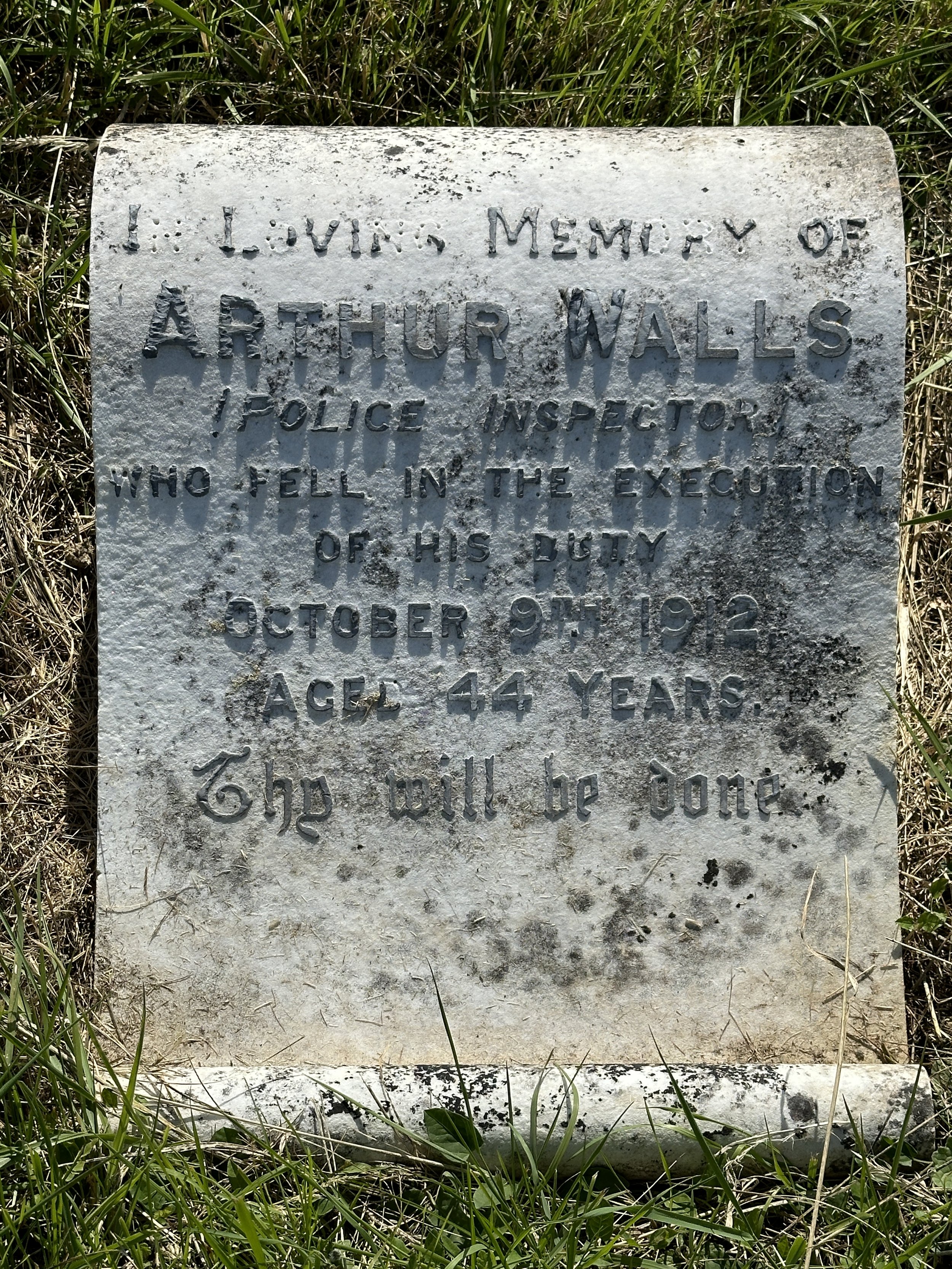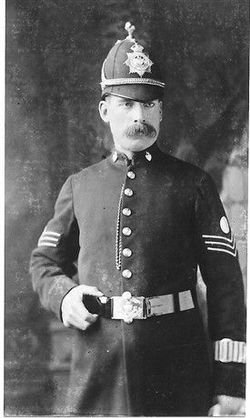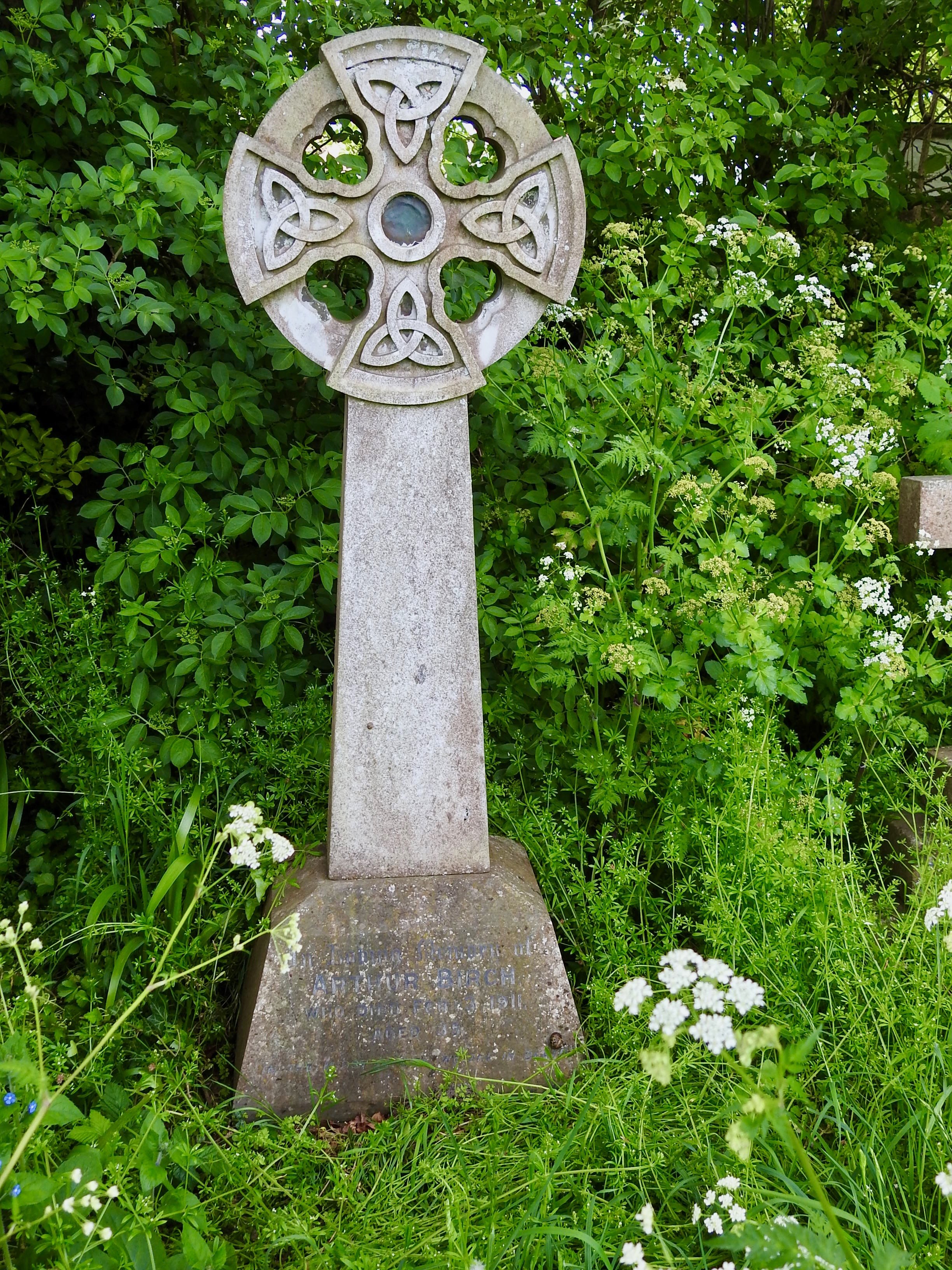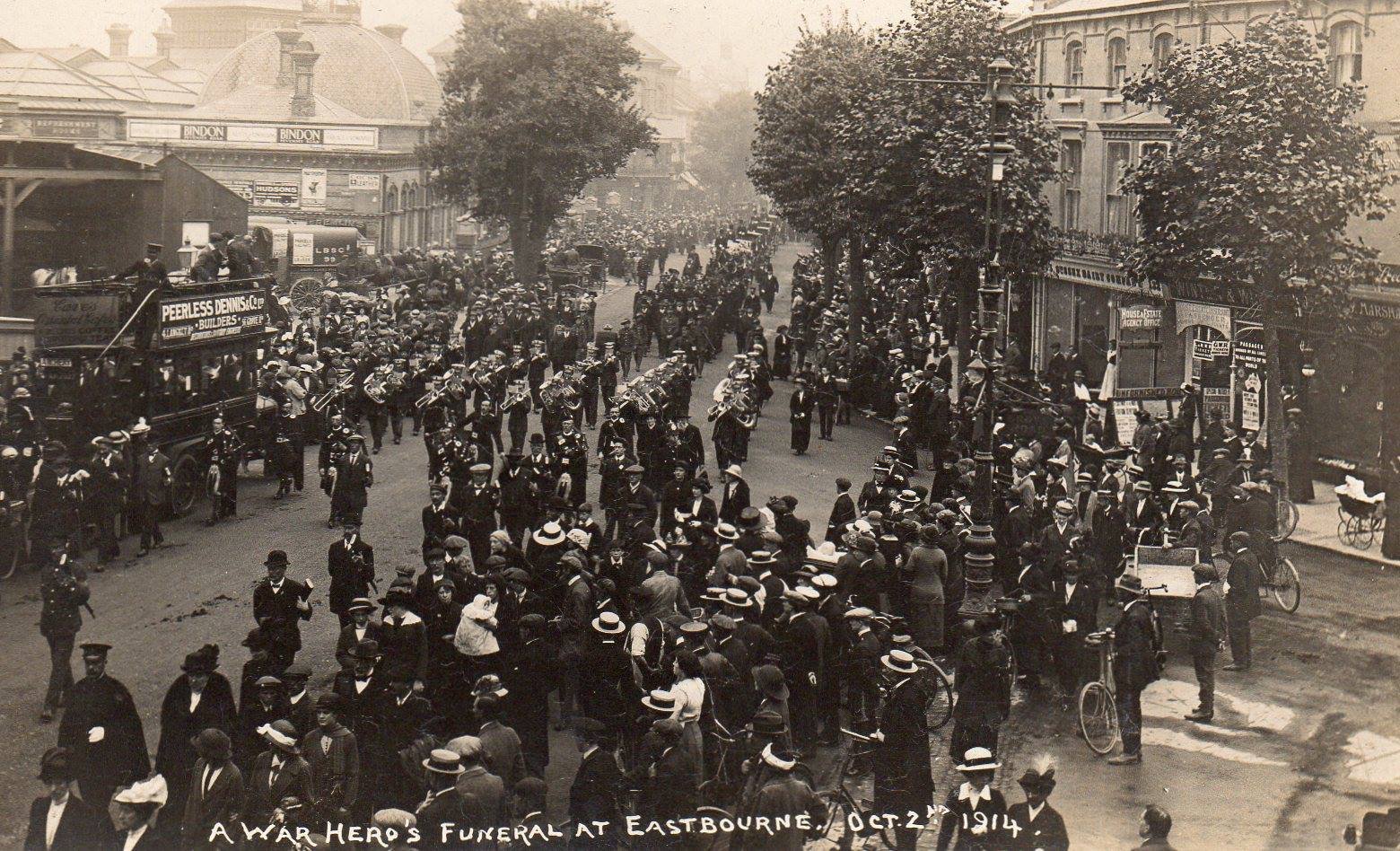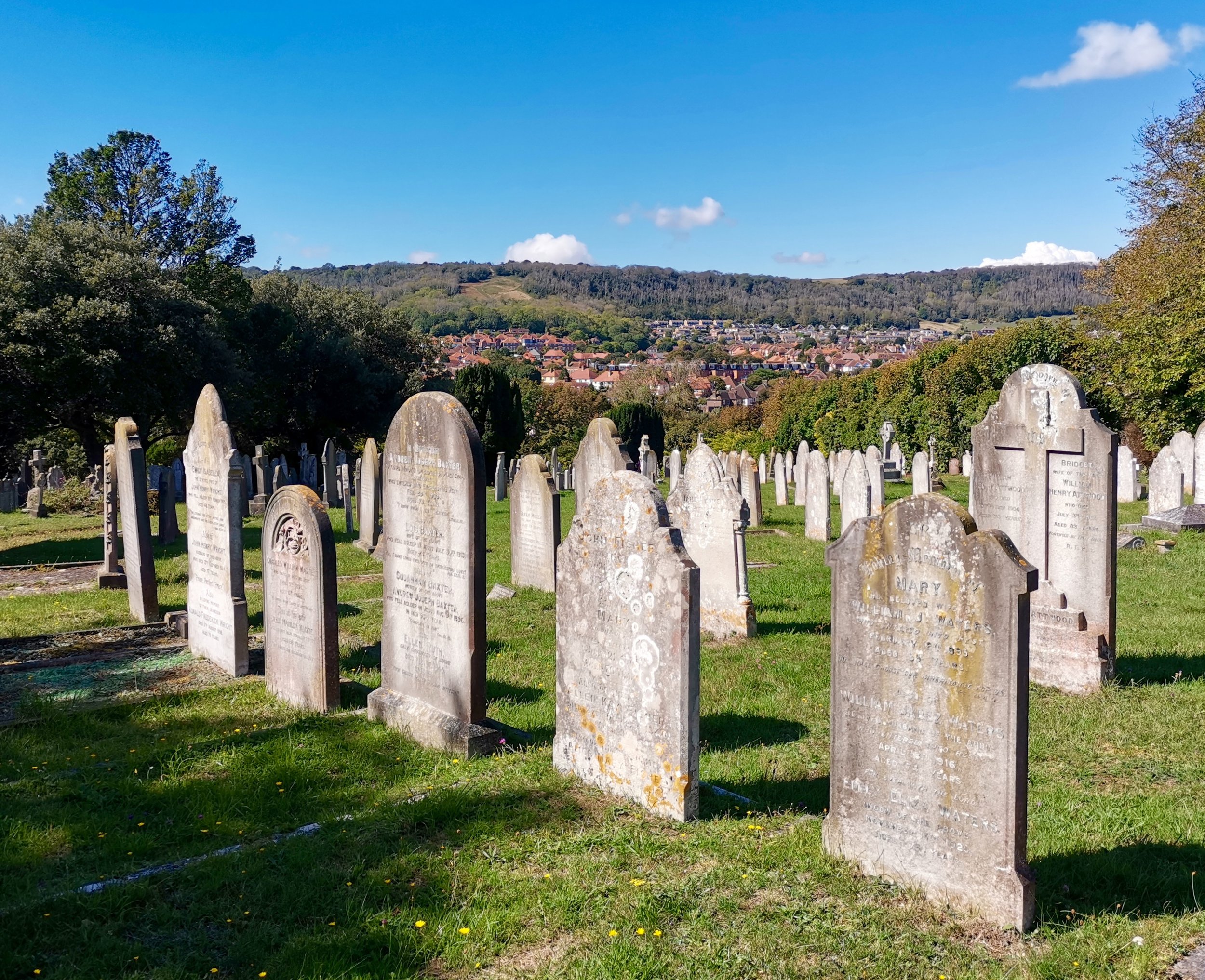
Notable graves
George Clark (Unusual Maritime Grave)
George was the son of Mr & Mrs Clark of 2, Addinghan Road, Eastbourne. He served as an able seaman in the Royal Navy Volunteer Reserve. During the Great War, he saw action in the Dardanelles (Turkey) on board HMS Princetown (a repair ship) and HMS Mars (a troop ship). He died of influenza at the Royal Naval Hospital in Chatham. Unusually, a photograph of George is inlaid into the gravestone. It is very rare to see such a large (and presumably costly) memorial for a man of the ‘lower ranks’ and even rarer to see a photograph of a Great War victim on his grave. It is probable that the Eastbourne Fishing Community helped to pay for the grave.
Carol & Ken Lawry (RAF Heroes)
Carol was an adventurer who enjoyed hiking, caving and climbing. She was the first recorded woman to have climbed Mount Kenya. She joined the Women’s Auxiliary Air Force just two weeks after war was declared in 1939 and served at RAF Kenley as an aircraftswoman (1st Class). This is probably where she met her husband Kenwyn (known as Ken). Although at 37 she was ten years his senior, they married at Torquay in July 1940.
In October 1940 Carol took leave to visit Ken’s mother in Eastbourne. She had told her mother-in-law that she was pregnant. They were window shopping outside Bobby’s department store in Terminus Road when an enemy bomb fell in nearby Lismore Road. Carol pushed her mother-in-law to the ground to protect her but was struck by shrapnel. She was taken to St Mary’s Hospital but died the following day.
Ken returned to Eastbourne to comfort his mother, whose life had been saved by his wife, and to bury his wife and unborn baby here. He was later promoted to sergeant but his interest in life had been lost with his wife. He was posted to 413 Squadron of the Royal Canadian Air Force. This was a Catalina Flying-Boat squadron based at Sullom Voe on the Shetland Islands. He immediately volunteered for a dangerous mission to obtain aerial photographs of Tromso Harbour and other targets in the far north of Norway. It was his first mission and was to be his last. The aircraft never returned. He has no known grave but is commemorated here and on the Runnymede RAF memorial.Susan MacDonald (First Lady of Canada)
Susan Agnes Bernard was born in Jamaica but her family emigrated to Canada where she met lawyer and diplomat John MacDonald. He was also a Canadian MP. When he travelled to England in 1867, Susan travelled with him and they were married in London. That same year, John became Canada’s first Prime Minister. He was knighted so Sarah became Lady MacDonald. She was therefore not only a Lady but Canada’s first - First Lady.
He served two terms as Prime Minister. In 1886 he set off with his wife to travel across Canada via the Canadian Pacific Railway. Susan wanted an unrestricted view of the magnificent Rocky Mountains but was disappointed to have to sit inside the train compartment. The 50 year old Lady Macdonald therefore insisted that she was strapped to the cow-catcher on the front of the train to get a better and rather exhilarating view!
After her husband’s death in 1891, Queen Victoria conferred a barony on Susan so that she could keep her title. She travelled extensively and liked staying in the South Coast resorts. She died in Eastbourne in 1920 at 47, Grand Parade.
Henry Mitchell Jones (Victoria Cross hero)
Henry was born in Dublin and served in the 7th Regiment of Foot (later the Royal Fusiliers). He saw action in the Crimean War. During the Battle of Alma on 20th September 1854. he was shot in the face but survived. Despite his injuries, he remained in the Army. The following year he fought at the Siege of Sebastopol. By this time he had been promoted to captain. Despite being hurt, repeatedly led his men to attack the enemy during the night of 7th June. He continued to do this until daylight and was later awarded the Victoria Cross for his bravery.
Henry left the army and joined the Diplomatic Service where he had a distinguished career. He served as a consul in Fiji and on the Island of Tonga before being appointed the Consul-General in Iraq (1868) and Norway (1875) and later Bulgaria (1880). He was then promoted to Resident Minister in Siam (Thailand) and later served as a British diplomat in Peru and Ecuador.
During the 1880s, he went to the dentist complaining of constant toothache. The dentist found a bullet lodged in his jaw that had been in place since the Battle of Alma some 30 years earlier! When it was removed, his toothache stopped! He retired in 1898 and settled in Eastbourne. He died in 1916. (His grave incorrectly gives his name as Henry Michael Jones)
Arthur Walls (Murdered Police Inspector)
On 9th October 1912, Arthur Walls, a Police Parade Inspector, was called to a house in South Cliffe Avenue. A man had been seen on the porch above the door attempting to enter the house. Inspector Walls attended, called up at the man “Here old chap, come down” but was answered by two shots, one hit him in the leg followed by a fatal shot to the chest.
The Chief Constable authorized officers to carry firearms whilst they searched the area. Police took plaster casts of a number of footprints in the garden, found a cloth cap nearby and used bloodhounds to follow trails. The murderer George MacKay alias John Williams was arrested and later executed for the crime.
Inspector Walls was buried here on 16th October. It was a massive funeral and thousands of people lined to route of the parade through the town centre where the shops closed in a mark of respect.
Eugenio Possolo (Brazilian Pilot)
On 5th September 1918 1st Lieutenant Possolo was one of three Brazilian Navy pilots to take off from the Eastbourne Aerodrome with three English pilots for an exercise. The leader of the formation, Captain Frank Creasy RAF witnessed a Sopwith Camel piloted by Lieutenant Reginald Sanders fly to an altitude of 1,500 feet before descending at speed. Sanders failed to see Lt Possollo’s plane (also a Sopwith Camel) and struck it. Both aircraft crashed to the ground near Friday Street farmhouse. The pilots, both 24-years-old, were killed.
Lt Possolo was buried at Ocklynge but Lt Sanders, whose parents lived in King’s Drive, Hampden Park, was buried in London. The Coroner returned a verdict of ‘accidental death’. Interestingly, a newspaper report of 26th July 1920 states ‘The Brazilian cruiser The San Paulo, will visit England to convey back to Brazil, the remains of the dead aviator Lieut. Possolo’. It is possible that this did indeed occur, but as his name is still recorded by the CWGC, this is doubtful. A road in Rio de Janeiro “Rua Tenente Possolo” is named after him.
Oswald Fitzgerald (Friend of Kitchener)
Fitzgerald is the most senior rank buried at the cemetery. His funeral was attended by thousands. He was born in India, the son of Sir Charles Fitzgerald. Oswald was a lieutenant in the Indian Army. In 1904 he joined the staff of Lord Kitchener who was then the Commander-in-Chief of the Army in India . In 1911 he travelled to Egypt with Kitchener who had been appointed Consul-General there. In July 1912 an assassin tried to murder Kitchener but Fitzgerald shielded him and probably saved his life. The two men became good friends and Kitchener called him ‘Fitz’. At the outbreak of the Great War, Kitchener became the Secretary of State for War and Fitzgerald was appointed his personal military secretary and given the rank of brevet lieutenant colonel. The following year, Fitzgerald became a Companion of the Order of St Michael and St George (CMG) in the New Year’s Honours List.
On Monday 5th June 1916, Lord Kitchener and his staff embarked from the Orkney Islands to HMS Hampshire which was to take them to Russia where Kitchener was due to negotiate with the Russians. Oswald Fitzgerald spoke fluent Russian and naturally accompanied his friend and senior officer.
At 7.50am HMS Hampshire struck a newly laid German mine and sank within 15 minutes. Only 12 men survived from a crew of 655. The bodies of most of the officers and men who were recovered were buried in a mass grave on Orkney. The body of Fitzgerald was identified and sent to his home town, Eastbourne, for burial. On arrival at Eastbourne station, his coffin was transferred to a gun-carriage which was pulled by six horses to All Saints’ Church where the funeral took place, officiated by the Bishop of Chichester. This was a huge event and crowds lined the streets to Ocklynge Cemetery for the burial, which was reported in the Times. Marching at the head of the parade were the Bluecoats - men from the nearby Summerdown Convalescent Camp. He was buried next to his father, who had died in 1912.
This simple but elegant gravestone was designed by Charles Rennie Macintosh, the famous Glaswegian architect. A short piece of Pathe newsreel showing the funeral can be viewed on line. Dozens of soldiers can be seen firing a volley across the grave.
Lancelot Keay (Architect)
Lancelot Herman Keay was born in 1883. His father was the Mayor of Eastbourne. After an education at Eastbourne College and the Brighton School of Art , he was appointed as an architect to Norwich City Council. He was responsible for the restoration of the city Guildhall. During the Great War, he served in the Royal Engineers. Whilst in France in 1916, he received a gunshot wound to the back and was evacuated home. He recovered and later saw service in Egypt. On return to civilian life in 1921, he was appointed Chief Architectural Assistant to the City of Birmingham where he was responsible for designing and building 16,000 new homes.
In 1925 Lancelot was appointed Chief Architectural Assistant for the City of Liverpool. In 1929, he became the ‘Director of Housing’. He wanted people to live in healthy modern houses and was responsible for slum clearance and the four large development schemes to provide social housing. These estates became models for similar housing schemes around the world. One of the councils houses he designed is 20, Forthlin Road, Liverpool, the childhood home of Paul McCartney and according to the National Trust that now owns it, the house was “The Birthplace of the Beatles”.
Lancelot was the President of R.I.B.A. (Royal Institute of British Architects) from 1946 to 1948 and served on the post-war ‘National Housing Advisory Committee. In 1947 he was knighted. The great architect was also a sports fan. Apparently he wrote to ITV on several occasions about their wrestling programmes. In 1956, he presented eight benches to be placed at the Saffrons, Eastbourne’s central sports ground.
Sarah Wentworth (Wife of Australian politician)
Sarah was born in Sydney, Australia. She was the daughter of two criminals and her parents met on the ship transporting them from England to Australia.
In 1822 she got engaged to a Captain John Payne. Two years later he broke off the engagement. Sarah decided to sue for Breach of Promise. She chose an up-and-coming lawyer, William Charles Wentworth, to represent her.
The pair had much in common. His parents had also met on a prison-ship en-route to Australia - his father having been transported for highway robbery. William’s legal skills won her the case and she received £100 compensation and a lot more - she had William’s child and they married in 1829.
William became a successful lawyer and was a representative in the Australian Senate. He later became the President of New South Wales Legislative Council. He is known as the ‘Father of Australian Democracy’.
After William’s death in 1873 (he was the first Australian to have a State Funeral) Sarah travelled to England and settled in Eastbourne. She died in 1880 and was buried here. A previous headstone (laying flat - see picture) has since been replaced by a newer one in 2016.
There is a museum on the Wentworth estate at "Vaucluse House" https://mhnsw.au/visit-us/vaucluse-house/.
George Ambrose Wallis (First Eastbourne Mayor)
The name George Wallis is intertwined with the development of Eastbourne. He was a Civil Engineer and came to the town in 1864 to become the Agent for the Duke of Devonshire, supervising the building of parades, roads, sea-walls and buildings.
Wallis was a Freemason, Justice of the Peace, Patron of the Eastbourne Cycle Club, Flower Club and Swimming Club. He was a governor of the Princess Alice Hospital and a Director of the Queens Hotel and led the Council of Eastbourne College.
The look of Eastbourne today owes much to Wallis. He laid down the Western Parades, Dukes Drive, Devonshire Park and built the Waterworks, Theatres and Swimming Baths - indeed he was known as the ‘Architect of Eastbourne’
In 1883, when it was decided that Eastbourne should have a Mayor there was only one man for the job - George Ambrose Wallis. He must have been popular as this portrait of him was paid for by public subscription. He died at the young age of 55 years and is buried in this small plot at the cemetery. However, the press said ‘All of Eastbourne is his Tomb’
Sinden Grave (Pockmarked by a bomb)
The grave of Mary Ann and Edmund Sinden in Ocklynge Cemetery, Eastbourne is badly damaged.
The couple married at Folkington Church on 11th May 1856. Edmund was a master brewer by trade. They ran a brewery in Lewes and later moved to Isfield where he ran The Isfield Milling and Baking Company. On retirement, the couple moved to Eastbourne. When they died, they were both buried at Ocklynge cemetery.
Edmund and Mary Ann laid at rest in peace together until 1pm on Sunday 7th March 1943. Sixteen Luftwaffe bombers attacked Eastbourne. Fourteen people were killed in the carnage they left. One 500 lb bomb landed in the centre of Monceux Road, bounced over Green Street and Milton Road before landing in the cemetery. Two people visiting the cemetery were killed in the subsequent explosion. Shrapnel shattered windows in Willingdon Road and damaged many graves. Most of the damaged graves were repaired but, as Edmund and Mary Ann had no family, their grave still clearly shows the damage caused by the bomb.
It is not many obituaries which have an interesting story to tell before and after they died!
Archdale Memorial (Large grave with angel)
Mervyn Archdale came from a well-off family near Enniskillen in Northern Ireland. He flunked at Oxford University but joined the army where he rose to the rank of Captain. When his uncle retired as MP for the County of Fermanagh in 1834, Mervyn took the job and was returned unopposed for nine General Elections, keeping the seat until 1874.
Mervyn had a high rank in the Orange Order and also kept racehorses (his most successful named The Flying Dutchman). He married Emma Inez Goulding in 1861 and ten years later he was living in Cornfield Road, Eastbourne. This splendid memorial was erected for his wife after her death in 1874. At one stage the centrepiece was protected by glass and you can still see the brass fixings. Mervyn died in Cannes, France in 1895 but his body was returned to Eastbourne and he was interred here with his wife.
Tommy Cooper (Comedian)
Thomas Frederick Cooper was born in Wales but when he left school he became a shipwright in Southampton. During the War he served in Egypt with Montgomery’s ‘Desert Rats’ and later joined the NAAFI where he started to entertain the troops with his jokes and (failed) magic tricks. Tommy married Gwen Henty from Eastbourne in Cyprus. The couple lived in Chiswick but had a holiday home near Motcombe Gardens. His daughter ran a Magic Shop in Cornfield Road, Eastbourne.
Tommy died on stage in 1984. Although he is not buried in the cemetery (his ashes were scattered over his favourite daffodils in his back garden), Tommy Cooper is remembered on the family grave of his wife here at Ocklynge.
Solomon Grave (Politician and Suffragette)
Saul Solomon was a South African Politician who died in 1892. On his death a newspaper in the ‘Cape Colony’ said “The Native people of Africa will forever remain in debt to Saul Solomon and his name will be handed down in the history of our country as the greatest champion of the rights and liberties of the native population at a time when they remained unrepresented. He was not guided by the thirst for distinction or popularity as his position was unpopular. He was guided by a pure love of justice.”
Saul was born on the island of St Helena in 1817. His family had links to Southern Africa and London. In his early years, he attended a Jewish School in London where he contracted rickets. This stunted his growth and affected his limbs but this did not deter him from living a full life. He moved to Cape Town and set up business as a printer. He also founded The Old Mutual Insurance Company which is now one of the largest financial institutions in Africa.
When the South African Parliament was established in 1854, he was elected as one of its first MPs. On his election he declared that he would oppose all legislation which tended to introduce distinctions of class, colour or creed. He was so short that he had to stand on a chair when he spoke in Parliament.
Saul was true to his word and although unpopular, was always re-elected, remaining an MP until his death. An opposition MP said of him that he was “The ablest man in South Africa and a remarkable stateman. He is an able debater, a splendid fighter and an energetic, upright and consistent politician. He is animated by noble and generous impulses and has devoted his whole life to preaching the equality of all races and classes”
In 1873 he met the headmistress of a Cape Town girls school – Georgiana Margaret Thompson. She was half his age and they married the following year but she was a modern woman and refused to promise to ‘obey’ him as per the normal marriage vows.
The couple lived at Clarensville House in Cape Town. They entertained not only local politicians but also African tribal leaders. The couple had six children but when their eldest daughter drowned in 1881, Saul withdrew from his public life. The family moved to England living in Penge and Bedford. They also had a house called ‘Windsor’ in Kilcreggan in Scotland and it was here where Saul died in 1892.
I have not been able to establish why, after his death, his body was brought to Eastbourne for interment at Ocklynge Cemetery but he shares his grave with his wife Georgina who was a celebrity in her own right.
Georgiana Margaret Thompson was born in Scotland in 1844. Her mother, Margaret Scott, was a relation of Sir Walter Scott. In 1873 she sailed for South Africa to become the Headmistress of a girls school there. Here she met Saul Solomon and they married in 1874. She was a powerful public speaker, a total abstainer and a lifelong woman suffragist.
Even after moving to England after the death of her husband, she had strong political ties with South Africa. In 1902 she founded the South African Woman’s Federation with Annie Botha, the wife of the first Prime Minister of South Africa.
In England she joined the newly established Women’s Social and Political Union with her daughter Daisy. She joined demonstrations in the early 1900s and was seriously injured, twice arrested and imprisoned. In 1909, when the Prime Minister refused to answer her letters, she posted her daughter Daisy to 10, Downing Street! (see photo)
She was involved with the ‘Black Friday’ event of 18th November 1910 when a peaceful protest in London was violently broken up by the police leading to many of the women demonstrators being beaten and sexually assaulted. She wrote a widely circulated letter to Winston Churchill, the then Home Secretary. She became friends with Elizabeth Garratt Anderson, the first British woman to qualify as a doctor.
In 1912 she was imprisoned for a month at Holloway for breaking the window of the Black Rod’s Office in Parliament. She said she was proud to be a political prisoner despite the Evening Standard describing her as a ‘Stout Old Lady’. The following year she became friends with Mahatma Gandhi.
Georgiana died in Eastbourne on 24th June 1933. Although the press reported that she was ‘visiting Eastbourne’ (at the time her home address was Helenslea Gardens in Golders Green, London), she must have had a connection to the town other than it being the resting place of her husband.
John Tosswill (Professional footballer)
John (known as Jack) was born in Eastbourne and lived at 59, Victoria Drive. He was a talented all-round sportsman. He started playing for Tunbridge Wells FC then Maidstone FC before joining Queens Park Rangers as a professional footballer. He later transferred to Liverpool FC and was picked for eleven matches. He later played for Southend FC and finally Coventry City FC being selected 17 times in the 1914-15 season and scoring one goal.
Jack was deaf which led to some amusing occasions as he was unable to hear the referee’s whistle. On several occasions kicked the ball into the goal when play had been stopped for a foul.
In July 1914, just a few days before the outbreak of war, Jack played cricket for Eastbourne against an Essex side making 122 runs. He joined the Motor Cycle Section of the Royal Engineers and went to Biggleswade for training. His call up was reported in the several newspapers. The Liverpool Echo of 28th January 1915 reported ‘You will remember our forward Tosswill who went to Coventry but received a bad injury at the City ground in September. He is now to be found in the Royal Engineers at Bedford where he is in the motor section. Tosswill says he is having the time of his life.’ “We have not the care in the world in this camp. I should like to be remembered to all my Liverpool friends. I should like to see the team a bit higher in the League but no doubt they will begin to climb shortly. With all good wishes - Have you an old football?”
Jack was taken ill and returned to Sussex but died in the Eastern General Hospital in Brighton as a result of an operation. An obituary in the Coventry Telegraph of 4th October 1915 reported ‘He played as a forward and was rather eccentric in his game but was at times capable of showing flashes of real brilliance and was a useful goal getter. He was a well-educated and gentlemanly young man with an agreeable disposition’.
Arthur Birch (Grand National Winner)
Arthur Birch was born in Staffordshire in 1875 and spent his short life horseracing.
Arthur started winning flat races in the 1890s. His first notable win was at the Somersetshire Stakes in 1892, winning on ‘Good Boy’. He then turned to steeplechases, winning on many occasions. The Sporting Life said he was a ‘capital judge of pace and frequently shone in a tight finish’
In October 1896 Arthur married Louisa Agnes Steadman at Lewes and the couple settled in the town.
In 1904 Arthur rode a New Zealand horse ‘Moifaa’ in the Grand National and won by eight lengths. After the race, the horse was bought by Edward VII. The press called him a ‘clever and high-couraged rider’.
In 1907 Arthur was riding ‘Black Ivory’ at Gatwick Racecourse when his horse fell. As he was getting up he was struck by another horse and his back was broken. After convalescing in Eastbourne, he returned home but remained severely disabled and unable to walk. He enjoyed the stay in Eastbourne so much that his family settled at Saville House, Victoria Drive and. It was here that he died aged 35 years in February 1911. He was buried at Ocklynge Cemetery on 7th February and there were many wreathes from the horseracing community including one from Richard Marsh, the horse trainer to the King. He left a widow and four children.
Henry Benbow (The Man who Mended the Boiler)
This grave has the curious text “THE MAN WHO MENDED THE BOILER”. Henry was a naval engineer. In 1884 he was on board the steamship Safia proceeding down the Nile in order to rescue General Charles Gordon. During the journey an enemy shell hit the boiler of the ship causing it to burst. Under enemy fire and working overnight he managed to fix the boiler and the ship was able to continue. (Although it was too late to rescue Gordon). Benbow became a celebrated hero and a music-hall song was written to commemorate his brave deed.
He later became the Chief Inspector of Machinery for the Royal Navy. He retired to Eastbourne, dying in 1916.
Rube Grave (Largest in Cemetery)
This is largest memorial in the cemetery and takes up six plots. It is the last resting place of the Rube family who made their money from diamond mining. Charles Rube became a director in DeBeers, the world’s largest diamond company. They lived in London but after their son went to school at St Andrews, they moved to live nearby in Meads. When their son Ernest died whilst serving in the Royal Dragoons in India, they paid for improvement to St John’s Church and this large grave was constructed. It is said that it was tall enough to be seen from the family home at Meads.
After her husband died, Mrs Rube worked as a volunteer in military hospitals in the town. She died in 1935 shortly after being visited by Queen Mary who was on her visit to Compton Place with George V.
Edward Langford (Eastbourne’s first Great War victim)
Although born in Northampton, Private Langford lived in Wellesley Road, off Tideswell Road, Eastbourne. He was a van driver for the London Brighton & South Coast Railway. He joined the Bedfordshire Regiment with his brother Luther in 1907. They were called up as reservists at the outbreak of war. They were some of the first to see action in the war and fought at the Battle of Mons. After the battle he was resting in an orchard when he was shot by a sniper. His brother found him and carried him to safety. Edward was repatriated to a hospital in Woolwich and later transferred to the Central Military Hospital (later St Marys) in Eastbourne where he died aged 23. His brother was killed in action the following year near Ypres and is buried at Dickebusch Military Cemetery in Belgium.
Edward was the first Eastbourne victim of the Great War and thousands turned up for his funeral and burial.
Matthew Freeman (Lusitania survivor)
Matthew was born 11 May 1895 in London. He was a waiter on the Lusitania, possibly working in the 2nd class dining room.
Matthew survived the sinking of the Lusitania. He later became a cloth buyer and returned to New York in 1916 and lived there for some time. Later in life, he claimed to have been a passenger on the Lusitania, but he was in fact a crew member on the ship.
He died in Eastbourne on 24 March 1968, aged 72.
copyright: Peter Engberg-Klarström 2017
Matthew Freeman, about 19, was a British citizen and waiter aboard Lusitania. He is reported in Hoehling and Hoehling as the amateur lightweight boxing champion of England. During the sinking, he helped lower the boats and injured his hand in the process. Marie Depage helped bandage his hand. Once Marie bandaged his hand, he tried to find a way off the ship. He ran to the stern, now the highest part of the ship, and looked over the edge. He wondered if it was a bit too high for him to dive from there.
Remembering that he was an athlete, he gathered his self confidence. He climbed over the railing and dove. As he landed, his head struck the side of a floating lifeboat. Blood started to ooze from the wound. Though a bit dazed, he maintained consciousness and started swimming.
Freeman was submerged a second time by a man who had grabbed him, “eyes bulging with fear”. Freeman surfaced again and swam to a deck chair. Dr. Daniel Moore called to him to urge him to grab the other side of the keg several times. They and four other men struggled to hold on to the keg to keep afloat. Freeman grew faint, but harsh speaking roused him. Once Freeman said: “I am going to go,” but Moore ridiculed this and it gave him strength. By stroking with their legs they succeeded in reaching an upturned lifeboat with about a dozen people clinging onto it.
They were in the water for about an hour and a half. Moore vomited from the exposure but kept himself going. Freeman collapsed, half-conscious. There were about twenty-three persons on the raft, but in the hours that followed many dropped off. Freeman recalled “ten of them died beside me there in the water”.
They were picked up by the patrol boat Brock. By then, only five, including Freeman and Moore, were still alive and clinging to the lifeboat.
copyright: Michael Poirier
Ipeson Peyton (Arts and Crafts Grave)
The grave of Edward Peyton is a distinctive golden ‘Arts and Crafts’ style memorial formed from two oak trees arching over to form a canopy of stone leaves.
Edward Ipeson Peyton was born in 1897. He was educated at Lancing College in West Sussex. At the age of 18 years, he enrolled as a Cadet in the Royal Navy. During the Great War he served on the dreadnought HMS Superb as a Midshipman and would have seen action during the Battle of Jutland in the North Sea.
After the war, Edward remained in the Royal Navy and by 1927 had been promoted to Lieutenant-Commander. Two years later he was serving on HMS Frobisher which was a ‘heavy cruiser’ serving in the Atlantic Fleet.
In April 1932 Edward got engaged to Hilda Anna Wessells. Two years later he joined the staff of the Captain of HM Dockyard, Devonport.
Edward died at The Royal Naval Hospital in Plymouth in November 1936 during an operation for acute appendicitis. He was just 38 years old. After his death, his body was transferred by train to Eastbourne for burial at Ocklynge Cemetery. Hilda remained in Eastbourne and died in 1988. She is buried under the beautiful oak-leaves of her husband’s grave.
Sr. Annie Whisler (Rescuer of Jewish children during WWII)
Born in Canonbury, Islington, London in 25-Mar-1870 to John & Elizabeth Whisler. One of 5 children.
In 1911, she is a missionary, living in Ventnor, Isle of Wight. She is known to have also spent time in Algeria as a missionary.
Annie was the co-originator and manager of the Association of Stars and Starlets. She was also the deputy superior of the Friedenshort diaconate in Miechowice in Upper Silesia (now Freudenberg, Germany) - founded by Ewa von Tiele-Winckler (known around the world as Mother Ewa of Miechowice). Annie was the author of the first biography of Ewa von Tiele-Winckler, her faithful friend and confidant. For 6 years after Mother Ewa's death, she served as the centre's manager, before Frieda von Hedemann took over the position. In 1939, just before the outbreak of World War II, she left Miechowice, taking several children to England - Friedenshort's charges - children from local Jewish families.
Friendenshort is a network of German orphanages. In the months before the outbreak of WWII, Jewish families became concerned for the welfare of their children. Some families put their children into the Friendenshort orphanages, in the hopes that they would be better protected against the Nazis, thereby saving their children’s lives.
Four young Jewish children were among the last to make their escape from Friedenshort in Germany. They formed part of the Kindertransport which saved over 10,000 Jewish children by giving them shelter in Britain. They arrived in Harwich on 29 June 1939. They were taken in by English families. One of them, in particular, was adopted by their foster parents and spent the rest of their life in England. They married and had 4 children, 9 grandchildren and 2 great grandchildren.
In much the same way as the Jewish children Nicholas Winton saved, these 15 people are now alive because Sr. Whisler saved this young person by taking them out of Nazi Germany.






